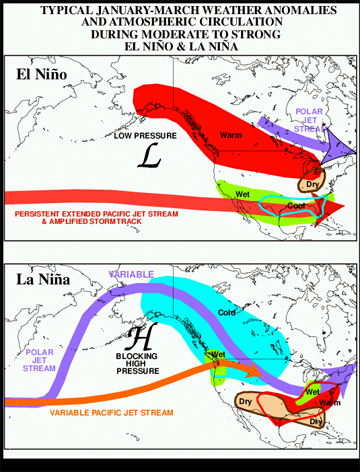AN ABUNDANCE OF SPRING WILDFLOWERS
At Casitas de Gila Guesthouses in Southwest New Mexico
Elusive-Yet-Magnificent Doubting Mariposa Lily?
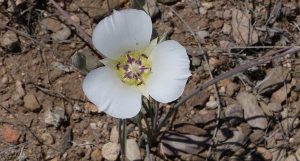
Typically, Spring wildflowers at Casitas de Gila Guesthouses begin to appear in protected sunny areas during the last half of February, with a peak in late March or April, and a decrease in May with the onset of the dry season. Species diversity and relative abundance of Spring flowering plants in Southwest New Mexico are primarily controlled by the amount of precipitation and average temperature during December, January, and February. As explained in the Casita Nature Blog of January 2015, these factors are strongly controlled by the cyclical pattern of the warm versus cool phases of equatorial surface waters in the Pacific Ocean, known as El Niño Southern Oscillation (ENSO), where the warm phase, El Niño, results in warmer temperatures and more precipitation, and the cool phase, La Niña, results in cooler temperatures and less precipitation.
During the Winter of 2014-15, Southwestern New Mexico was experiencing a weak El Niño phase with an exceptional and well-above-average amount of precipitation in the form of both snow and rain. During December 2014 and January and February 2015, Casitas de Gila received a total of 3.72 inches of precipitation (which included the exceptional seven-inch snowstorm of January 2, 2015). As a result, with the coming of Spring in 2015, guests at the Casitas were treated to an amazing extravagance and profusion of common, as well as rarely seen, wildflowers, such as the magnificent Doubting Mariposa Lily that emerged between early March and late May. This spectacular flowering of Spring 2015 had not been witnessed in the 14 years of previous operation of the Casitas de Gila. Nor has it been repeated since. The flowering was so spectacular that two separate blogs were written at the time to celebrate the event. Readers of this blog will find most of these flowers identified, discussed, and profusely photographed in the March 2015 and April 2015 blogs.
WILDFLOWER PROGNOSIS FOR 2019 AT CASITAS DE GILA GUESTHOUSES
It is with this background, then, that we can turn to the prognosis for wildflowers for Spring 2019. Climatic factors prevailing during the Winter months of 2018-19 continue to closely match the climatic factor experienced during the same period of 2014-15.
Primary Climatic Factors Affecting Spring Wildflowers in Southwest New Mexico
Precipitation
Total precipitation at Casitas de Gila so far this Winter (December 2018 thru February 23, 2019), which includes an 8-inch snowstorm on December 28 and a 5-inch snowfall on January 1 and 2, totals 3.42 inches, comparing closely to the 3.72 inches received for the same period in 2015.
El Niño Southern Oscillation
In addition to the precipitation similarities, other regional climate factors for December, January, and February for 2014-15 and 2018-19 are also very similar, such as the phase of the El Niño Southern Oscillation (ENSO). The ENSO, as recorded on the National Oceanic and Atmospheric Administration’s Oceanic Niño Index (ONI), for both time periods shows the presence of a weak El Niño phase which favors more moisture in the Southwest during the Winter months.
Jet Stream Patterns
Integrally related to the ENSO phase for any given year in the Southwest are the prevailing atmospheric patterns of the Jet Streams. The El Niño Southern Oscillation (ENSO), manifests as irregular variations in winds and sea surface temperatures over the tropical equatorial eastern Pacific Ocean. These varying winds and temperatures, in turn, interact with and affect the major currents of air encircling the Earth in the Northern Hemisphere known as the Jet Stream. The Jet Stream consists of two distinct, rapidly-moving masses of air that encircle the Earth in both the Northern and Southern Hemispheres at elevations of 30,000 to 50,000 feet. In each hemisphere there is both a Polar Jet and a Sub-Tropical Jet. These two currents of air vary in position and pattern along with the seasons, and in the Northern Hemisphere are closely tied to the ENSO phenomena, as shown below from the National Oceanic and Atmospheric Administration.
This image shows the pattern that is normally experienced in the Southwest for El Niño jet streams during January-March. However, in recent years the Southwest has repeatedly experienced a much different, anomalous pattern which is well illustrated by the Winters of 2014-15 and 2018-19. In this anomalous pattern, the Polar Jet Stream repeatedly dips down from the Arctic in a southward loop along the West Coast of the United States, dragging with it embedded, moisture laden, low pressure systems which intersect and combine with the eastward moisture laden flow of the Pacific Jet Stream, resulting in above-average rain and snowfall to the Southwest. This recurrent jet stream pattern is illustrated below in three Archived Jet Stream Maps as produced by the Department of Earth and Climate Sciences at San Francisco State University. As can be seen in these maps, the Jet Stream pattern in the Southwest for the Winter of 2018-19. continues to be virtually the same as that of 2014-15.
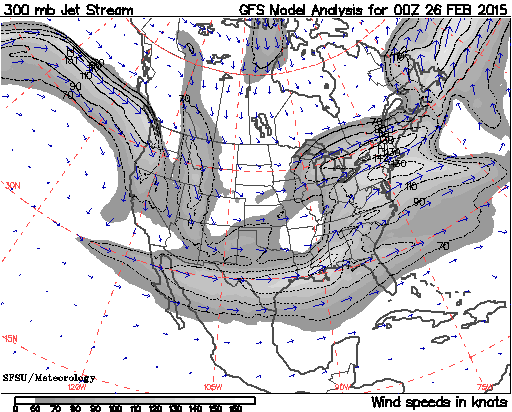
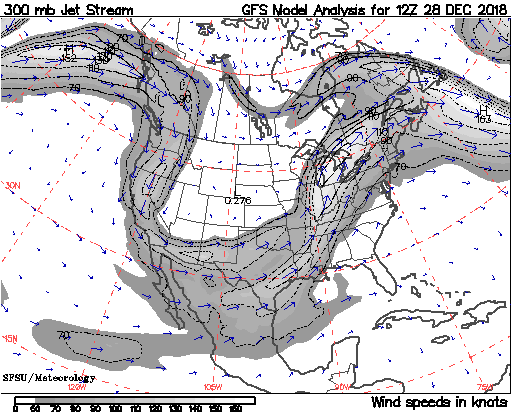
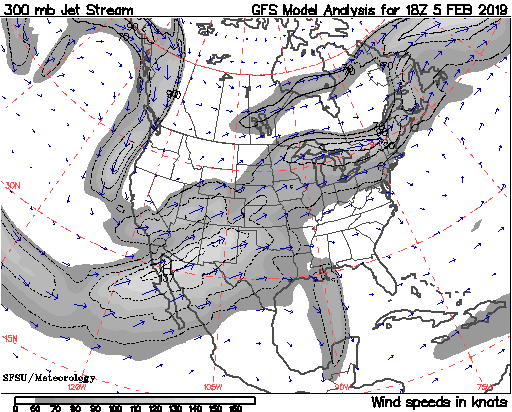
Effect of Cloud Cover Upon Ground Moisture Retention
A final climatic factor which greatly affects the abundance of Spring Wildflowers in the Southwest is the amount of cloud cover during the December–March Winter season. As discussed above, La Niña years are dry and cold in the Southwest. But in stark comparison to more cloudy El Niño years, La Niña years are also characterized by endless cloudless days of crystal clear, cobalt blue skies, illuminated by an incredibly brilliant Southwest Sun. As would be expected, all of these sunny days quickly evaporate most of the scant moisture that might fall during the La Niña Winter months, but are also very effective at drawing out moisture retained in the soil left over from the previous Summer monsoon and rainfall during the Fall. Thus, La Niña years typically have a much lower ground moisture content going into Spring than the wetter and cloudier El Niño years, which leads to a much reduced showing of both numbers and species of wildflowers.
Days of increased cloud cover always accompany the arrival of moisture-bearing low pressure weather systems. Thus, greater precipitation, cloud cover, and consequently increased ground moisture retention, are to be expected during Winter seasons such as 2014-15 and 2018-19 where the Polar Jet Stream with embedded low pressure systems repeatedly drop down into the Southwest to merge with the moisture laden Pacific Jet Stream.
AND THE WILDFLOWER PROGNOSIS FOR 2019 IS . . .
In this Blog both the 2014-15 and 2018-19 Winter seasons have been shown to be extremely similar with regards to all of the climatic factors, which would favor a Spring wildflower showing of exceptional abundance and diversity. Assuming that there are no great changes in the climatic factors during the coming month, guests at Casitas de Gila during March through May are highly likely to witness a bountiful repeat of the exceptional 2015 Spring Wildflower florescence!

